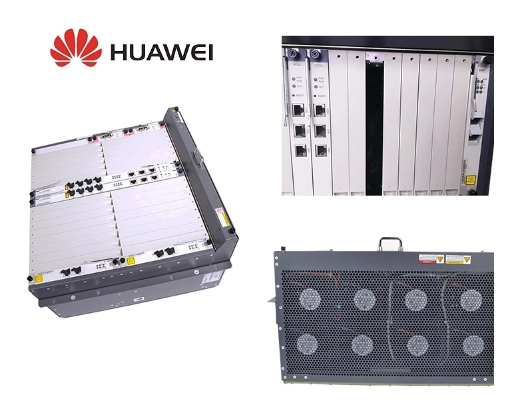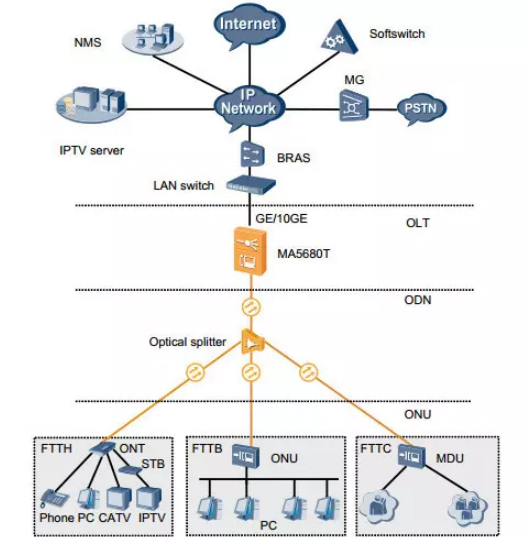
Huawei MA5680T Gpon/Epon OLT

The MA5680T provides high capacity, high rate and high
bandwidth voice, data and video services. To be specific:
The MA5680T works as an Optical Line Terminal (OLT) on a GPON
network to work with the Optical Network Unit (ONU) and the Optical
Network Terminal (ONT).
The MA5680T supports rich network applications such as FTTH, FTTB,
FTTC.
The MA5680T meets the requirements of the Base Station Transmission
Network, IP Private Line Interconnect and Wholesale Multi-ISP.
The MA5680T supports FE Point-to-Point Optical Access (P2P). By
cooperating with the ONT, the MA5680T provides users with FT2 P2P
access.
Large capacity platform with aggregation access and integration:
Developed based on the iMAP hardware platform and Huawei's IAS
software platform, the MA5680T series product carries on advanced
architecture and design.
The switching capacity of the motherboard is up to 3.2 Tbit / s, and
the bidirectional switching capacity of the control card is up to
480 Gbit / s.
High density GE / 10GE interfaces for cascading, up to 36 * 10GE or
384 * non-GE interfaces, need additional investment from aggregation
switches.
Each GPBD board supports eight GPON ports, based on the 1: 128 split
ratio, the subrack only supports up to 8K ONTs. In 2012, Huawei will
release 16-port GPON board that can support 16K ONTs.
Sharing the development platform with Huawei broadband access
devices, the MA5600T series product supports Layer 2 and Layer 3
functions of broadband access devices to provide user-oriented and
future-oriented functions .
GE / GPON / NGPON that coexist on the same platform.
Aggregation switches.
No type of access:
The capacity of arge IPTV provisioning service, 8K multicast users
and 4K multicast channels and simultaneous 2k multicast channels.
HQoS QoS level 3 support (different ISP / service user) guarantees
wholesale OLT.
Access for traditional E1 services, native TDM or traditional CESoP
E1 business service and mobile base station access.
E-LAN function for local traffic interconnection, meeting the
needs of the company and the network campus.
Powerful integrated GPON access capability:
Supports bandwidth. The downstream rate up to 2,488 Gbit / s and the
upstream rate up to 1,244 Gbit / s.
Supports long distance. The maximum physical transmission distance
of the ONT is 60 km. The physical distance between the farthest ONT
and the closest ONT can be up to 20 km.
Supports high split ratio. The GPON 8-port board supports 1: 128
split ratio, which increases access capacity and saves fiber optic
resources.
High density support. The MA5600T series provides 8 ports and 16
GPON Committee ports to increase system capacity
Powerful QoS Capability:
Supports priority control (based on port, MAC address, IP address,
TCP port ID or UDP port ID), prioritization and modification based
on the field of ToS and 802.1P and DSCP differentiated services.
Supports bandwidth control (based on port, MAC address, IP address,
TCP port ID or UDP port ID) with 64 kbit / s granularity of control.
Queue supports three programming modes: priority queue (PQ),
weighted round robin (WRR), and PQ + WRR.
It supports HQoS, which ensures the bandwidth of multiple services
for multiple users: the first level ensures the user bandwidth, and
the second level ensures the bandwidth for each service of each
user. This ensures that the allocated bandwidth is absolutely
allocated and allocates the download bandwidth quite a bit.
Specification
|
MA5680T (ETSI) |
MA5680T (IEC) |
||
|
Indoor cabinet: N63E-22, N66E-18 Outdoor cabinet: F01T500, F01D2000 |
ndoor cabinet: N66E-22 Outdoor cabinet: none |
||
|
2 slots for control boards 16 slots for service boards 1 slot for the universal interface board 2 slots for upstream interface boards 2 slots for power interface boards. |
2 slots for control boards 14 slots for service boards 1 slot for the universal interface board 2 slots for upstream interface boards 2 slots for power interface boards. |
||
|
Supported control board and its switching capacity |
SCUN: 480 Gbit/s in active/standby mode or 960 Gbit/s in load-sharing mode |
MCUD/MCUD1: 128 Gbit/s in active/standby mode or 256 Gbit/s in load-sharing mode |
|
|
System Layer 2 packet forwarding rate |
SCUN: 726 Mpps in active/standby mode or 1452 Mpps in load-sharing mode
|
MCUD/MCUD1: 190 Mpps in active/standby mode or 380 Mpps in load-sharing mode |
|
|
Switching/Forwarding delay |
Short forwarding delay: The 100 Mbit/s Ethernet port sends the 64-byte Ethernet packets at a delay shorter than 20 μs. |
||
|
BER in full load |
BER of a port when the port transmits data in full load < 10 e-7 |
||
|
System reliability specifications |
System: redundant configuration. System availability for the typical configuration: > 99.999% Mean time between failures (MTBF): about 45 years. NOTE: Due to different network environments and different boards used by devices, the preceding MTBF (45 years) of the MA5600T/MA5603T/MA5608Tis only for reference. The average repair time for field replaceable units (FRUs) is about 2 hours. The preceding values are only for reference. For details, contact the related Huawei engineers. |
||
|
Maximum number of ADSL2+ ports in a subrack |
1024 |
896 |
128 |
|
Maximum number of VDSL2 ports in a subrack |
1024 |
896 |
128 |
|
Maximum number of EFM SHDSL ports in a subrack |
512 |
448 |
64 |
|
Maximum number of TDM SHDSL ports in a subrack |
256 |
224 |
32 |
|
Maximum number of POTS ports in a subrack |
1024 |
896 |
128 |
|
Maximum number of ISDN BRA ports in a subrack |
512 |
448 |
64 |
|
Maximum number of ISDN PRA ports in a subrack |
64 |
64 |
64 |
|
Maximum number of GPON ports in a subrack |
256 |
224 |
32 |
|
Maximum number of 10G GPON ports in a subrack |
128 |
112 |
16 |
|
Maximum number of P2P FE ports in a subrack |
768 |
672 |
96 |
|
Maximum number of P2P GE ports in a subrack |
768 |
672 |
96 |
|
Maximum number of upstream ports (GE ports in the GIU slot) in a subrack |
8 |
8 |
- |
|
Maximum number of upstream ports (10GE ports in the GIU slot) in a subrack |
4 |
4 |
- |
|
Maximum number of upstream ports (PON ports in the GIU slot) in a subrack |
2 (in the active/standby mode) |
2 (in the active/standby mode) |
- |
|
Maximum number of upstream ports (ports on the control board) in a subrack |
SCUN: 8 x GE (in the load-sharing mode) |
MCUD: 8 x GE (in the load-sharing mode) MCUD1: 4 x GE + 4 x 10GE/GE (in the load-sharing mode) |
|
|
Maximum number of extended subracks connected to a master subrack |
32 |
32 |
- |
|
Maximum number of ONUs supported by each subrack |
· For Layer 2 applications, the maximum number of ONUs supported by each subrack is determined based on the number of MAC addresses and service flows supported by the control board, as well as the number of MAC addresses and service flows planned for the ONUs. · For Layer 3 applications, the maximum number of ONUs supported by each subrack is determined based on the number of routes and ARP entries supported by the control board. |
||

Solutions

.
Model
Huawei MA5680T Xpon OLT
 Download
Download



